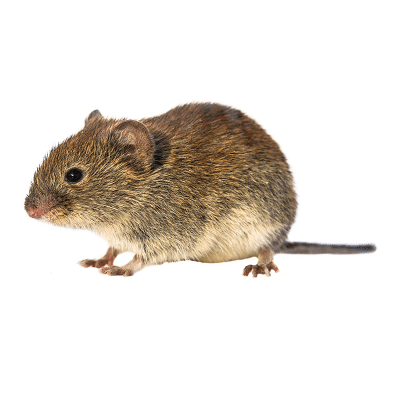
Color: Fur is brown or grey, often mistaken for a mouse
Size: Seven inches in length.
Voles are small furry rodents that can be found throughout North America living in underground burrows. They measure four to seven inches in length with an average weight of one ounce. Grayish brown in color, voles’ distinguishing features include stocky, rounded bodies, blunt noses, relatively small eyes and flattened ears.
Voles are very often mistaken for mice. They are similar in appearance but their ears are back against their heads rather than standing up and the tail is shorter, like it had been cut off or docked.
In underground burrows.
Voles are poor climbers and usually don’t enter homes or other buildings. Instead, they inhabit wild lands or croplands adjacent to buildings or gardens and landscaped sites with protective ground cover. Most problems around homes and gardens occur during outbreaks of vole populations.
Voles are vegetarians, thriving primarily on plants, roots, grasses, tree bark, fruits and nuts. They are hearty eaters, consuming their weight in food every day. Voles like dining on succulent root systems and will burrow beneath ground cover and plants, gnawing away at the vegetation until they kill it. Bulbs, another favored food, are easily accessible to voles, thanks to their tunneling prowess.
- Voles will often eat succulent root systems and will burrow under plants or ground cover and eat away until the plant is dead. Bulbs in the ground are another favorite target for voles; their excellent burrowing and tunneling skills give them access to sensitive areas without clear or early warning. The presence of large numbers of voles is often only identifiable after they have destroyed a number of plants.
Runways and Burrows
A good indicator that you have voles in your yard is the visible, above ground runways that connect their burrow openings. These well-defined, surface runways, about two inches wide, are typically constructed in grassy areas.
Vole runways are formed by a combination of voles eating the grass blades and the steady traffic from their shallow underground burrow to seek food along the runways. Runways are often hidden by ground cover, so you may have to pull back overhanging cover to find them.
The opening to a vole burrow can be identified by neat, round holes that measure an inch or two in diameter. Vole holes can be found in open turf or hidden under ground cover, plantings or mulch.
Plants & Trees
Another tell-tale sign of a vole infestation are plants that have wilted or appear yellowish. If a light tug on a plant lifts it easily from the soil, chances are good that its roots have been devoured by a vole.
When green vegetation is scarce, voles will gnaw on the bark of fruit trees or shrubs. Vole damage to tree trunks is normally found a couple of inches above ground to a few inches below ground. When a vole gnaws completely around the trunk or roots it and can cause the tree or shrub to die. Signs of tree damage by voles are a delay in fruit production and uncharacteristic leaf color.
In addition to trapping and repelling voles, these prevention methods can help to reduce the potential risk of voles taking over your lawn:
- Mow grass to a short height.
- Eliminate ground cover and dense vegetative cover around your home. Both provide food for voles and protection from predators.
- Minimize the amount of mulch in your yard and turn mulch frequently to discourage voles from establishing tunnels.
- Protect young trees and shrubs with a 12-inch tall fence made of hardware cloth. Bury the cloth three inches into the ground to create a barrier that will keep voles away.
Manufacturer Recommended Products And Treatment For Voles Control
Pests need food, water, and shelter. Often the problem may be solved just by removing these key items. Before even thinking about chemical pest control, it is important to be aware of
| Conducive Condition | Recommendation | |
| 1 | Tree branches on house | Keep tree branches away from house to reduce pest access |
| 2 | Firewood next to foundation | Keep firewood away from house to reduce pest harborage |
| 3 | Debris on crawlspace/next to foundation | Remove wood debris to reduce termite ha rborage area |
| 4 | Excessive plant cover, stump, etc. | Providing spacing between plant cover and structure |
| 5 | Soil above the foundation Ii ne | Keep soil below top of foundation to reduce harbo rage areas |
| 6 | Wood-to-ground contact | Keep soil from touching wood to eliminate termite access |
| 7 | Debris on roof/full gutter | Keep gutter & roof free of debris to reduce insect harborage |
| 8 | Standi ng water near/under structure | Eliminate standing water to reduce pest harbo rage |
| 9 | Mo isture problem under structure | Increase ventilation to reduce pest harbo rage area |
| 10 | Openi ngs at plumbi ng & electronics | Seal opening to reduce pest access |
| 11 | Excessive gaps at windows/doors | Seal gaps to reduce pest access |
| 12 | Lea ky plumb ing fixtures | Repair to reduce moisture for pests |
| 13 | Keep garbage cans covered | Covered to reduce attraction of insects of vertebrate pests |
| 14 | Mo isture damage wood | Repair rotten or damaged wood to reduce insect harborage |
| 15 | Grocery bags stored improperly | Seal paper sacks in containers to reduce i nsect ha rborage areas |
| 16 | Pet food unsealed or left out | Keep pet food in sealed containers and unavailable to pests |
| 17 | Excessive storage conditions | Keep storage areas uncluttered and manageable |
| 18 | Debris below kick plates | Remove kick plates to reduce rodent harborage |
1 product


